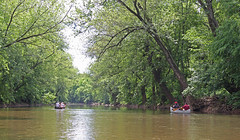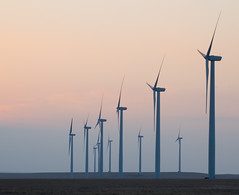The Great Convergence (of environmental values)

Posted May 18, 2010 at 1:30PM
Today I am happy to feature another post by my friend Lee Epstein, an attorney, land use planner and environmentalist working in the mid-Atlantic region. Enjoy.
Don’t worry: The Great Convergence doesn’t refer to some part of Oak Creek canyon in Arizona where energy fields come together to create a magical aura. And it is surely not about the Republicans and the Democrats in Washington finally seeing the light, holding hands around a campfire, and singing “Kum-Ba-Ya” in three-part harmony as the dusk deepens from purple to black. That ain’t gonna happen any time soon.
It refers, instead to the convergence of several scientific and public policy matters of great importance to those who would call themselves “environmentalists.” For many years, our interests, and our interest groups, quite logically separated out among related but different topics, for example, wildlife or wilderness conservation, clean water advocacy, or work on air pollution.  By the early ‘90s, the management of growth had itself grown into another certifiable movement of its own, ultimately called in some circles “smart growth” after a policy initiative in Maryland in 1997.
By the early ‘90s, the management of growth had itself grown into another certifiable movement of its own, ultimately called in some circles “smart growth” after a policy initiative in Maryland in 1997.
These wide-ranging and disparate issues were always united in the minds of those whose vision was ecological, rather than merely political. After all, that is what ecology teaches: that these various threads concerning the interaction of human activity with the natural world are all part of a greater, interwoven fabric and, if one of those threads is pulled, the whole fabric is affected. But that is theory and philosophy, and in the “real” world, topical silos prevailed.
The times they may be a-changin’. In part, this may be the result of better science. Environmentalists of all stripes are coming to realize that the interactions among the various agents of environmental change are so strong that if “sustainability” (and indeed, survivability) has any meaning to us as a species, the human endeavor on this planet must be adjusted in all its facets, together.
Take climate change (as the comic Henny Youngman used to say, “please!”). It is all about the carbon and greenhouse gases that are changing our climate dynamics – ocean and atmospheric currents, solar heating and cooling, glaciers and polar ice caps. Significant and in some cases drastic changes on the earth’s surface are nearly inevitable.  But think about these interactions. Mostly, our usage of fossil and carbon-based fuels is what stimulates anthropomorphic alteration of climate processes.
But think about these interactions. Mostly, our usage of fossil and carbon-based fuels is what stimulates anthropomorphic alteration of climate processes.
So climate change is surely an air pollution technical control problem. It is also an energy supply and energy use problem. It is a problem related directly to how we grow and distribute our food, how and where we build houses and commercial centers, the form and efficiency of our means of transport. And all of these problems interact within the sphere of public policymaking at local, state, national, and international levels of governance. Thus, environmental organizations that may formerly have mostly dealt with the arcane regulatory intricacies of the federal Clean Air or Clean Water Acts, now mostly understand how the way the land is developed to accommodate population growth can drastically affect the use of energy and the pollution spewing from the tailpipes of vehicles or the smokestacks of public utilities.
The environmental non-profit that formerly focused solely on saving this or that endangered species of plant or animal through narrowly crafted, single-species protection plans, now understands the need for broad, multi-species, multi-habitat conservation initiatives that inevitably also affect the course of urbanization in a large region. The organization that previously sued Big Industry and Big Utilities for polluting our rivers, is now working to promote stormwater management solutions that include basic urban redevelopment as a legitimate tool, as well as it continues its efforts to protect wetlands.  The group formed to protect this scenic headland, the farmland nearby, or the great collar of forest around an urban center -- together with the group whose aim is to promote the economic and social health of the urban center itself -- are now much closer in thought than ever before, and are understanding their connection to the larger issues noted here, as well.
The group formed to protect this scenic headland, the farmland nearby, or the great collar of forest around an urban center -- together with the group whose aim is to promote the economic and social health of the urban center itself -- are now much closer in thought than ever before, and are understanding their connection to the larger issues noted here, as well.
The bottom line is that we cannot get “there” without this much broader definition of environmental interest. Sustainability as a concept must embrace and include attention to the full breadth of human endeavor on this planet, from shelter to fuel to transport to equitable economic development, and commercial and industrial activity as a whole. We’re not quite there yet as environmentalists (and less so as human society). Just like everyone else, we love our narrow expertise, we need our focus, and we still work within our silos. But I do sense a coming-together of diverse interests and understanding just as the links and webs that define sustainability and ecology are better understood. Just maybe there is a great convergence beginning. Surely, 40 years into the life of the modern environmental movement, the time has come.
Move your cursor over the images for credit information.